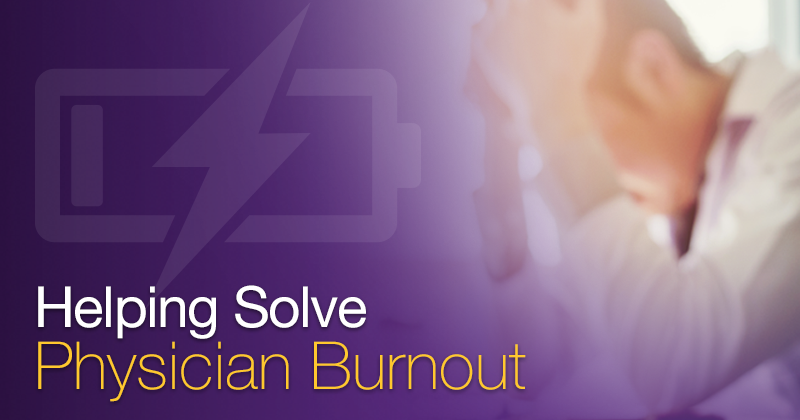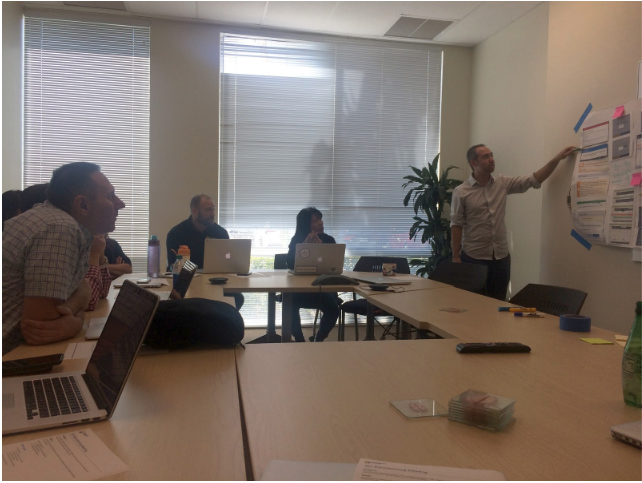Taking a User-Centered Approach to Help Solve the Challenges of Physician Burnout

Focusing on the Healthcare User Experience
The medical community has raised certain concerns related to physician burnout and many electronic health record (EHR) vendors are not only listening but taking action. Modernizing Medicine’s blend of research and design takes a “users first” approach to tackling some of the complex challenges associated with physician burnout.
Defining the Concern of Physician Burnout
In this article on Physician’s Practice.com, our co-founder and chief medical and strategy officer, Dr. Michael Sherling, shared how EHR systems aren’t to blame, but rather it’s poorly developed user interface design and inefficient workflows related to the technology.
This notion of EHR systems and workflows rang true at a recent industry event I participated in. At the Electronic Health Record Association’s (EHRA) annual Usability Summit on June 5, 2018, in Washington, D.C., during presentations and facilitated group discussions, I heard directly from representatives of major medical organizations about issues that contribute to physician burnout. As Modernizing Medicine’s representative on the EHRA Clinician Experience Workgroup, I facilitated a discussion with attendees to identify possible solutions that may be able to reduce the burden on medical staff related to documentation. Several themes addressed in this exercise included:
- Improve system workflows: match EHR workflows to how clinicians practice medicine
- Reduce data entry burden: look for opportunities to streamline documentation
- Decrease information overload: identify ways to better organize information and reduce alert fatigue
Aligning to the User’s Workflow to Increase Clinician Efficiency
EHR system vendors have the opportunity to greatly reduce the user’s cognitive load by creating navigation workflows that match their mental model and process for completing tasks. Healthcare user experience (UX) and the needs of specialty physicians and staff are baked into Modernizing Medicine’s DNA, as our team of on-staff physicians alongside developers help build our suite of products. The result? Workflows within the EHR tailored to the respective specialty.
Our UX team conducts research to better understand the operations of our clients’ practices through on-site observational studies, behavioral surveys and user interviews through user-centered design practices. Usability testing helps our teams to design a more user-friendly experience before it is released to all of our users. By iterating on our designs, we’re better able to work to optimize the placement of elements on the screen and adjust the workflow to the mental model of our users. At the end of the day, we want to continually improve our solutions to help physicians and their staff focus more on patients and less on documentation.
Spend Less Time Documenting Visits and More Time on Patient Care
The participants of the EHRA Usability Summit discussed the amount of time spent documenting a visit as a major contributor to the burnout of clinical staff. EHRA participants saw a lack of interoperability among systems as a time-consuming burden—necessitating entering duplicate data. Participants also mentioned prior authorizations (PA) are a time-consuming process for clinical staff.
Modernizing Medicine has focused efforts on streamlining the process for electronic Prior Authorizations (ePA). This would let providers know proactively whether a prescription would require a PA, thus helping to reduce data entry necessary to request authorizations and provide an easy way to check on the status of an authorization. Our UX team, with feedback from our clients, has been working to create an intuitive and efficient workflow for this process.
At Modernizing Medicine we utilize Big Data to analyze patterns of behavior across all of our users to better understand how they interact with our products. We are also exploring options to surface contextually-relevant actions within our applications and use Intelligence Amplification (IA) to recommend ways for users to automate routine items. These capabilities should allow our customers to work smarter and not harder to complete daily clinical tasks.
Helping to Reduce Information Overload
A growing problem in the healthcare industry includes alert fatigue which may result in serious adverse effects on patients when the wrong alerts are ignored. According to the Patient Safety Network:
The term alert fatigue describes how busy workers (in the case of healthcare, clinicians) become desensitized to safety alerts, and as a result ignore or fail to respond appropriately to such warnings.
Modernizing Medicine has established an Alerts Task Force consisting of doctors, UX designers and developers to closely examine the notifications presented to users in our products. The goal of this task force is to create a series of design patterns that will help reduce unnecessary distractions while ensuring that important messages are easily noticed.
 In addition to reducing distractions, we are also helping to make sure that the information presented in EMA™ is contextually relevant based on an individual’s role and responsibilities. In the future, we plan to incorporate dashboards to help synthesize our clients’ information to provide a quick overview of key information and the status of tasks. Our UX team works with both our internal team of doctors and clients to identify what information would be best served up in a dashboard layout.
In addition to reducing distractions, we are also helping to make sure that the information presented in EMA™ is contextually relevant based on an individual’s role and responsibilities. In the future, we plan to incorporate dashboards to help synthesize our clients’ information to provide a quick overview of key information and the status of tasks. Our UX team works with both our internal team of doctors and clients to identify what information would be best served up in a dashboard layout.
Future Opportunities: A Combined Effort Among EHR Vendors, Clinicians and Medical Staff to Reduce Physician Burnout
We love engaging our clients in the design process and often use participatory design techniques such as our interdisciplinary DesignLabs. These sessions involve providers, clinical support staff, product owners and UX designers to create solutions that may better align with how clinicians want to work to improve the operations of their practice.
With no one-size fits all approach, it’s all the more reason to work closely with our clients to continually improve and enhance their user experience and help diminish physician burnout.
We invite all current Modernizing Medicine customers to be actively involved in the process to provide feedback and to help design an even more usable and useful EHR system by joining our customer research panel.
